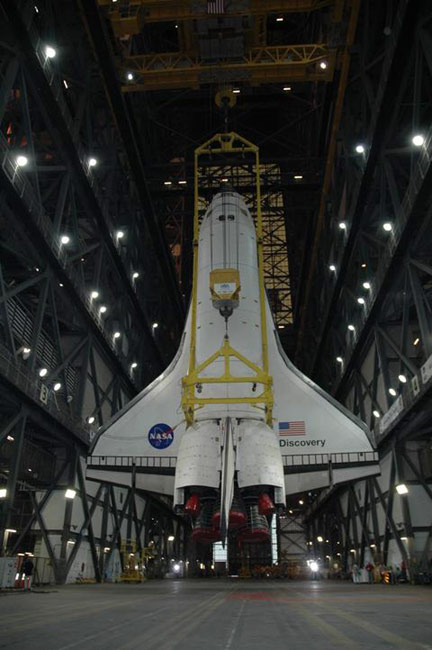Shuttle Discovery, Cargo Prepared for December Spaceflight

The piecesare coming together for NASA's nextshuttle mission as workers hoisted the space agency's Discovery orbiter towardsits flight position today.
Work crews hauledDiscovery into a vertical position by crane inside NASA's cavernous VehicleAssembly Building at the Kennedy Space Center (KSC) spaceport in Florida. There, the 122-foot(37-meter) orbiter will be mated to the external fuel tank and rocket boosters [image]that will aid its planned Dec. 7 launch towards the International Space Station(ISS).
"Everythingis going smoothly," NASA KSC spokesperson Jessica Rye told SPACE.com,adding that shuttle workers want to make sure nothing is moving on the orbiterbefore they connect it to the external tank [image].
Discovery'sSTS-116mission, commanded by veteran shuttle flyer Mark Polansky, will ferry a SPACEHABcargo module and a new ISS segment--the Port 5(P5) truss--to the orbital outpost in what is expected to be NASA'sthird shuttle flight this year. The STS-116 crew will also stage severalspacewalks to rewire the station's electrical grid.
The Tuesdayshuttle move was delayed severalhours to allow time additional landing gear inspections, NASA official said.
Discoveryrolled out of its hangar-like Orbiter Processing Facility Tuesday night atabout 9:23 p.m. EST (0223 Nov. 1 GMT), making the short trip to the 52-storyVehicle Assembly Building in about 34 minutes, Rye added.
Shuttleworkers are expected to spend about a week mating Discovery to its launch stackand checking their work before the entire assembly and its Mobile LaunchPlatform are hauled to Pad 39B.
Get the Space.com Newsletter
Breaking space news, the latest updates on rocket launches, skywatching events and more!
Meanwhile, ateam of cargo specialists have installed the 4,110-pound (1,864-kilogram) P5truss [image] into a container for later transport to Discovery's Pad 39Blaunch site. A SPACEHAB cargo pod will be placed into the canister on Nov. 4, withboth elements due for delivery to the Pad 39B's payload changeout room on Nov.6, NASA officials said.
The P5truss runs about 11 feet (3.3 meters) in length and 14 feet (4.2 meters) inwidth and height. The Boeing-built segment is destined for installation on theoutboard edge of the space station's Port 3/Port4 (P3/P4) truss, which NASA'sSTS-115 shuttle crew delivered last month. P5 is designed to serve as botha truss spacer and conduit to allow power, cooling and other vital systems toreach outer ISS segments.
Polanskyand his STS-116 crewmates examinedtheir shuttle and launch stack last month, and are completing final trainingsimulations for their planned December space shot.
"We arereally pleased with all the work that everyone has been doing to support us,"STS-116 mission specialist Joan Higginbotham told SPACE.com in a recent interview.
- Mission Discovery: The ISS Rewiring Job of NASA's STS-116
- Complete Space Shuttle Mission Coverage
- Complete Coverage: ISS Expedition 14
- The Great Space Quiz: Space Shuttle Countdown
Join our Space Forums to keep talking space on the latest missions, night sky and more! And if you have a news tip, correction or comment, let us know at: community@space.com.

Tariq is the Editor-in-Chief of Space.com and joined the team in 2001, first as an intern and staff writer, and later as an editor. He covers human spaceflight, exploration and space science, as well as skywatching and entertainment. He became Space.com's Managing Editor in 2009 and Editor-in-Chief in 2019. Before joining Space.com, Tariq was a staff reporter for The Los Angeles Times covering education and city beats in La Habra, Fullerton and Huntington Beach. In October 2022, Tariq received the Harry Kolcum Award for excellence in space reporting from the National Space Club Florida Committee. He is also an Eagle Scout (yes, he has the Space Exploration merit badge) and went to Space Camp four times as a kid and a fifth time as an adult. He has journalism degrees from the University of Southern California and New York University. You can find Tariq at Space.com and as the co-host to the This Week In Space podcast with space historian Rod Pyle on the TWiT network. To see his latest project, you can follow Tariq on Twitter @tariqjmalik.









